Elysia grandifolia
Kelaart, 1858
Order: SACOGLOSSA
Superfamily: ELYSIOIDEA
Family: Elysiidae
DISTRIBUTION
Indian Ocean?
Described by Kelaart from Ceylon, (Sri Lanka), it is very similar in colour to Elysia ornata. It is possibly the same species, but I think there are probably good grounds for considering it distinct. It grows to a very large size, 10cm or more, the parapodia are large and very thin, and the black and orange bands at the edge of the parapodia are not separated by white. I suspect that Elysia ornata and E. grandifolia are part of a group of similarly coloured species which need closer examination.
See Kathe Jensen's message for a discussion on the taxonomy confusion surrounding this and similarly coloured species.
Reference:
• Kelaart, E.F. (1858). Description of new and little known species of Ceylon nudibranchiate molluscs and zoophytes. Journal of the Ceylon Branch of the Royal Asiatic Society,
Columbo, 3(1): 84-139.
Rudman, W.B., 2001 (November 19) Elysia grandifolia Kelaart, 1858. [In] Sea Slug Forum. Australian Museum, Sydney. Available from http://www.seaslugforum.net/find/elysgran
Related messages
Elysia ornata? from Tel Aviv, Israel
November 25, 2009
From: Michael Kanzen
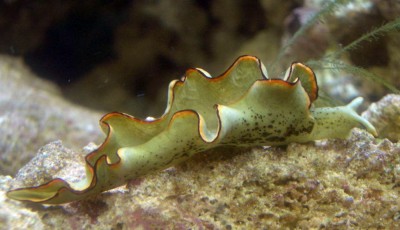
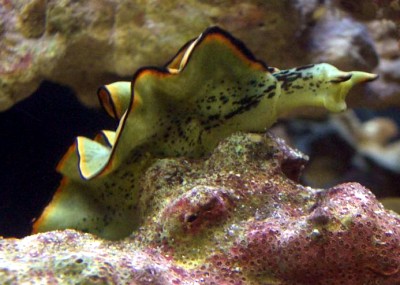
Hi,
Picture was taken at the coast of Tel Aviv, Israel by my son, Ben on the 17 October 2009. It is the first time I have seen them. Is it Elysia ornata?
Thanks
mike
Locality: Tel Aviv, Israel, 0.5 - 1 metres, Mediterranean Sea, 17 october 2009, intertidal, pier. Length: 10 cm. Photographer: Ben Kanzen.
Michael Kanzen
mkanzen@gmail.com
Kanzen, M., 2009 (Nov 25) Elysia ornata? from Tel Aviv, Israel. [Message in] Sea Slug Forum. Australian Museum, Sydney. Available from http://www.seaslugforum.net/find/22830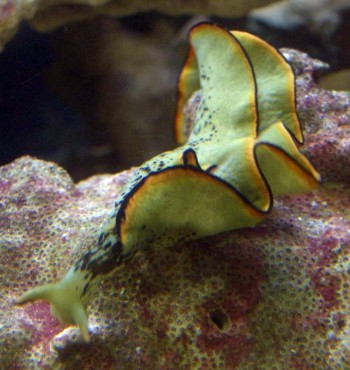
Dear Mike,
This is a species of Elysia. I suspect there is more than one species mixed up in the group we call Elysia ornata and at present I am calling this one with large, very thin, parapodial folds Elysia grandifolia. However if you look at the message from Kathe Jensen [message #5727], who is an expert on the elysiids, you will see a solution is not that simple.
Interestingly, all the animals I have tentatively identified as E. grandifolia have been reported from the eastern end of the Mediterranean. However there is general agreement that your species, whatever its name, originated in the Indian Ocean and made its way, in recent times, into the Mediterranean via the Suez Canal - a procees we call Lessepsian migration.
Best wishes,
Bill Rudman
Re: Elysia grandifolia? from Mediterranean Israel
October 18, 2005
From: M. Baki Yokes
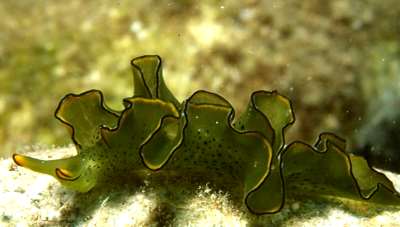
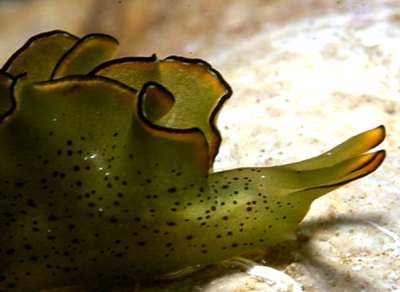
Dear Bill,
Although it is not as abundant as other alien species, Elysia grandifolia is regularly seen around Uc Adalar (Antalya, Turkey), especially in the beginning of summer. For the last three years we have recorded quite a few of them.
Locality: Uc Adalar, Antalya, Turkey. Mediterranean. Depth: 8 m. Length: 12 cm. June 2004. Rocky bottom. Photographer: Adnan Buyuk
Best wishes
Baki
bakiyokes@turk.net
Yokes, M.B., 2005 (Oct 18) Re: Elysia grandifolia? from Mediterranean Israel. [Message in] Sea Slug Forum. Australian Museum, Sydney. Available from http://www.seaslugforum.net/find/15019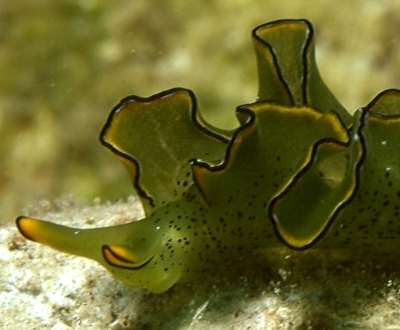
Dear Baki,
Thanks for these photos. The small black spots illustrated here are certainly more 'typical' than the forms with large black spots and patches which we have seen in recent messages.
Best wishes,
Bill Rudman
Re: Elysia grandifolia? from Mediterranean Israel
October 11, 2005
From: Tomer Halevy
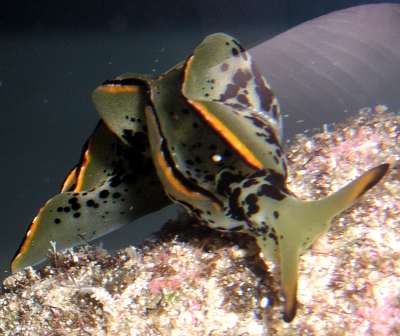
Hello,
Me and my brother have found several sea slugs in a small lagoon on the shore of Achziv, near the city of Nahariyya, Israel (probably very close to where Dan was diving) [message #14808 ]. We believe the slugs we have found are either Elysia grandifolia or Elysia ornata. They are a bit different from the one Dan found.
Locality: Nahariyya, Israel, Mediterranean Sea. Depth: 0.5-1.0 m'. Length: 4 cm. 05 October 2005. small lagoon. Photographer: Tomer Halevy
Tomer Halevy
tomerhalevy@hotmail.com
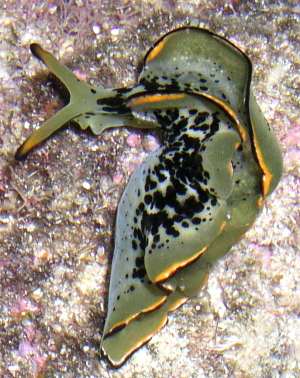
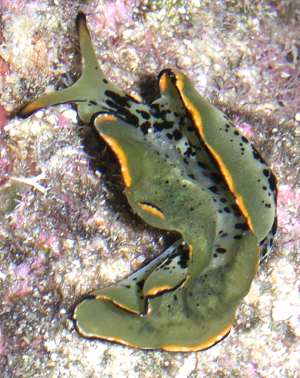
Dear Tomer,
Thanks for these photos. Your animal also looks quite like Jacob Dafni's photo from Eilat, in the Red Sea [#12946] of one with a black head. As I said in Dan's message, we eally won't know which name to use until someone reviews the anatomy and nomenclature of this group of species.
Best wishes,
Bill Rudman
Elysia grandifolia? from Mediterranean Israel
September 22, 2005
From: Dan Firer
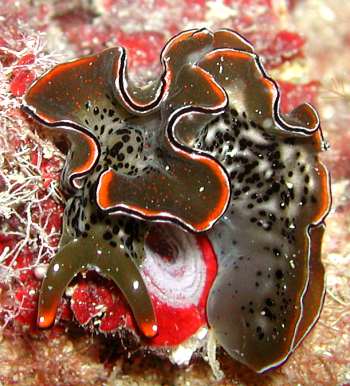
Hello Bill
My name is Dan, I took some photos of a slug near Naharyia, on the Mediterranean coast of Israel.
Locality: Nahariya, Israel. Mediterranean coast. Depth: 22 m. Length: 4 cm
17 September 2005. Photographer: Dan Firer
I saw a photo of this slug in an earlier message from Turkey [#5676 ]. I think my photo is a bit better in quality. I will send it to you so you can decide what to do with it.
Dan
danf@tx.technion.ac.il
Firer, D., 2005 (Sep 22) Elysia grandifolia? from Mediterranean Israel. [Message in] Sea Slug Forum. Australian Museum, Sydney. Available from http://www.seaslugforum.net/find/14808Thanks Dan,
Your photo does show quite a bit more detail, and it looks like you also photographed its white spiral egg ribbon at the same time. As you will see from the on-going discussion, there is still a problem with the identity of this group of species [see message #5727]. Your animal to me looks like the one photographed in Turkey which I suspect may be Elysia grandifolia, but at present we don't know whether this 'form' is just a large sized Elysia ornata? It is certainly good to get another photo. Hopefully it will help the experts to sort this problem out. All I can say is I am pretty sure it is a Lessepsian migrant the Red Sea.
Best wishes,
Bill Rudman
Re: Elysia ornata and E. grandifolia
November 26, 2001
From: Kathe R. Jensen
Dear Bill, Lucas and Baki,
The Elysia ornata/grandifolia complex is a very difficult problem. In 1992 I published my anatomical studies on specimens from the Canary Islands, Phuket (Thailand), Guam and Western Australia. I had also studied specimens from Florida, when I was working in Kerry Clark's lab. I could find no consistent differences between Atlantic Ocean, Indian Ocean and West Pacific specimens, so I concluded that they were the same species.
In 1997 I had a postdoc. from India staying with me in Copenhagen for about a month. He brought specimens and photos of something he had tentatively identified as Elysia grandifolia. The specimens had been collected from Bryopsis, and he had studied chemical from both animal and alga, so no doubt about the food. The pictures, however, were indistinguishable from E. ornata. We then dissected several specimens and made SEM of its radular teeth. The anatomy was indistinguishable from that of E. ornata. BUT: the radular teeth were very finely denticulate. The reason I have not yet published anything about this is that Dr. K. Padmakumar from India also brought specimens of 2 species of Elysia from Caulerpa, one of which has a black line along the parapodial margins. We did publish an abstract about these 3 species (Phuket Marine Biological Center Special Publication, 19(1): 245-46 (1999).
Let me try to outline some of the confusion about this species complex: Elysia ornata (Swainson, 1840) was originally described as Thallepus ornatus from the West Indies and trasferred to Elysia by Verrill (1901). I don't think we will ever know exactly what Swainson described, but since Verrill an Elysia ornata (Swainson) has been recorded from many localities in the Caribbean. Kelaart described Elysia grandifolia from Ceylon (Sri Lanka) in 1858. The description was very brief and without illustration. Pease described a species called Pterogasteron ornatum from "Sandwich Islands" (Hawaii) in 1860. Again without illustration. Pease's illustrations were published in Bergh (1881), and the species placed in the genus Elysia. In 1871 Pease described Pterogasteron marginatus from Tahiti, and this was illustrated in colour by Garrett.
Eliot (1906) examined Kelaart's specimens and unpublished illustrations, and although the specimens were unlabelled, picked out one as E. grandifolia, and used it for dissection. He described a long renopericardial ridge with 7 pairs of dorsal vessels, and finely denticulate teeth. This corresponds more to a Caulerpa-feeding species. O'Donoghue (1932) described specimens from the Gulf of Manaar, which he referred to E. grandifolia. The figure of the teeth, however, shows blunt tips and rather broad, denticulate blades, as in Caulerpa-feeding specimens.
There has been a series of other records from different localities in the Indo-West Pacific, some reporting smooth radular teeth, others denticulate. Carlson & Hoff (1978) reported both E. marginata and E. grandifolia from Bryopsis in Guam. E. marginata had smooth teeth, E. grandifolia denticulate teeth. In my 1992 paper I list a number of species with black and/or orange (red or yellow) marginal bands, which should also be considered for synonymy in this species complex.
So, I think there is one circumtropical species with black and orange parapodial margins, black and white spots, pointed teeth with or without fine denticles, and feeding on Bryopsis. However, we do not know whether this species includes E. grandifolia, since Eliot's description of Kelaart's specimen may not have been the one Kelaart had assigned to E. grandifolia. He had also described E. punctata from the same locality.
I don't know if this has clarified anything. At least I need to look at more specimens from more localities before the mess can be sorted out.
• Jensen, K.R. (1992) Anatomy of some Indo-Pacific Elysiidae (Opisthobranchia: Sacoglossa (=Ascoglossa), with a discussion of the generic division and phylogeny. J. Moll. Stud. 58(3): 257-296.
Greetings,
Kathe
jensen@ait.ac.th
Jensen, K.R., 2001 (Nov 26) Re: Elysia ornata and E. grandifolia. [Message in] Sea Slug Forum. Australian Museum, Sydney. Available from http://www.seaslugforum.net/find/5727Thanks Kathe,
I'm glad I'm not the only one who is unsure of this group. The animal I assume is E. grandifolia has extremely large, extremely thin parapodia. Alive, it just looks so different from the relatively 'normal' sized parapodia of what I assume in the Indo-West Pacific is Elysia ornata. If anyone has some photos of the Caribbean 'form' they would be a useful addition to the Forum
Best wishes,
Bill
Re: Elysia ornata? from Turkey
November 24, 2001
From: Juan Lucas Cervera
Hi Bill,
Maybe it would be helpful if Kathe Jensen can help us in this subject. She collected E. ornata in Canary Islands, recording for the first time this species in this archipelago.
Cheers.
Lucas.
lucas.cervera@uca.es
Cervera, J.L., 2001 (Nov 24) Re: Elysia ornata? from Turkey. [Message in] Sea Slug Forum. Australian Museum, Sydney. Available from http://www.seaslugforum.net/find/5715Re: Elysia ornata? from Turkey
November 22, 2001
From: Juan Lucas Cervera
Hi Bill,
Concerning Baki's animal from Turkey, Elysia ornata has been also recorded in Canary Islands, although no published or known records to date in Western Mediterranean.
Regards.
Lucas.
lucas.cervera@uca.es
Cervera, J.L., 2001 (Nov 22) Re: Elysia ornata? from Turkey. [Message in] Sea Slug Forum. Australian Museum, Sydney. Available from http://www.seaslugforum.net/find/5712Thanks Lucas,
I guess what needs to be sorted out is whether the Caribbean E. ornata is the same as the Indo-West Pacific E. ornata and whether the Indian Ocean E. grandifolia is different. I guess the Canary Island record is of the Caribbean 'species' or 'form'. Since there are no records of this from the western Mediterranean I guess Baki's animal from Turkey, is just as likely to be a lessepsian migrant as it is to be a visitor from the Caribbean. Just another little mystery to be solved
Best wishes,
Bill Rudman
Elysia ornata? from Turkey
November 20, 2001
From: Baki Yokes
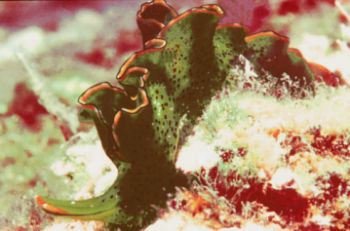
Dear Bill,
Here is a photo of a probable lessepsian sea slug captured in Antalya, Turkey. Unfortunately the colour slide have been developed as a negative film. I tried to recolour the photo on a photoshop program according to the observers directions, and now the colour of the animal is more or less like the original one. It looks like the Elysia ornata specimens posted on your Forum, but this one is rather big, around 12 cm. What is your opinion?
Photo data:
Place: Antalya, Turkey
Dive site: Uç Adalar
Depth: 5m
Size: approx. 12cm
Date: September 2001
Photo: Adnan Buyuk: ado2000tr@yahoo.com
Best wishes
Baki
bakiyokes@turk.net
Yokes, B., 2001 (Nov 20) Elysia ornata? from Turkey. [Message in] Sea Slug Forum. Australian Museum, Sydney. Available from http://www.seaslugforum.net/find/5676Dear Baki,
Firstly for those who don't know the term lessepsian, it is derived from Ferdinand De Lesseps who led the team that built the Suez Canal, thus linking the Red Sea with the Mediterranean. Lessepsian migration refers to species which have entered the Mediterranean, from the Red Sea, through the Suez Canal. I have given some references to lessepsian migrants in a reply to an earlier message
Your animal certainly looks like E. ornata but I think I would identify it as the Indian Ocean species Elysia grandifolia Kelaart, 1858 which I think is different but needs more anatomical study. It differs in its large size, very large and thin parapodia, and the lack of white band separating the black and yellow/orange bands on the parapodial border. I know of no records of either Elysia ornata or E. grandifolia from the Mediterranean so it looks like you have another new find.
Best wishes,
Bill Rudman
